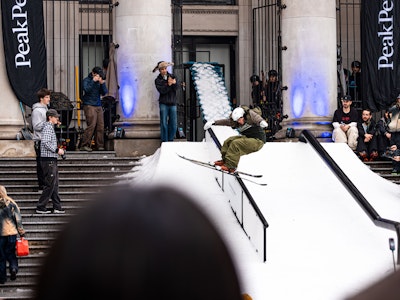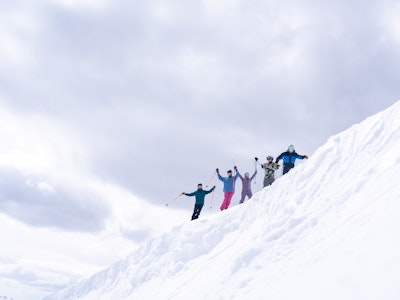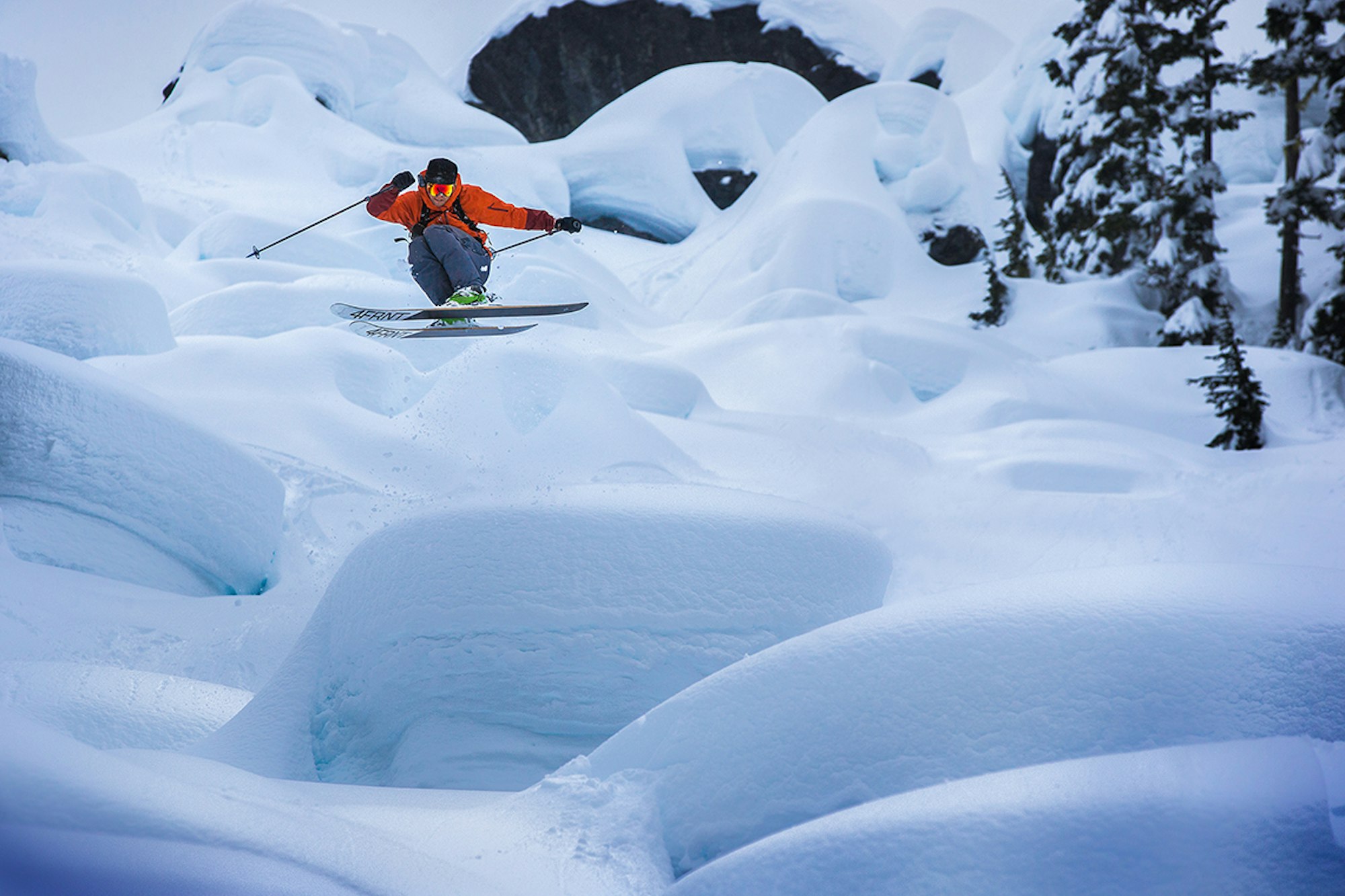

Eric Hjorleifson moves seamlessly from skier to innovator to entertainer
WORDS • AARON H. BIBLE | PHOTOS • ROBIN O’NEILL
To find out how one of the world’s best freeskiers and product designers gets a nickname like “Tinkerbell,” you have to dig deep. The skier in question, Eric “Hoji” Hjorleifson, was born in Banff, Alberta, and grew up in Canmore. His dad was a carpenter and stone mason, while grandpa was an aircraft mechanic; both passed on a robust passion for three-dimensional problem solving to young Hoji.
As a kid, Hoji built functional ski chairlifts out of Legos and made room-sized blueprints of his fantastical ideas on paper grocery bags that his mom would spread out across the living room floor. However, his infatuation with building things always came second to his love for the sport of skiing. Now 35, Hoji’s trajectory from a young ski racer to a pioneering freeskier, global product developer and all-around legend has been documented in the new film, Hoji, by Matchstick Productions (MSP).
“It’s the third dimension of the Hoji brand. He’s first and foremost a skier. He evolved into a product designer and now is really an entertainer,” says 4FRNT Skis founder Matt Sterbenz, who came up as a pro freeskier with Hoji and was the first to give him a shot at product design. The two are lifelong friends, and Sterbenz is eloquent in regaling the legend with deserved praise but also in recognizing the humility and imperfectness it takes to reach this point in one’s career.
Depending on who you ask, Hoji’s traits vary from a sensei and innovator, to a kook that’s the greatest skier of all time, to a loyal, yet stubborn friend. One thing everyone agrees on is that there’s something about Hoji that seems impossible to replicate. He has a matchless work ethic, a passion for getting things right and a relentless drive to innovate in pushing skiing’s boundaries, in style and in equipment design. He not only tinkers, but he personally tests his prototypes on the most demanding terrain on Earth. He’s persistent, relentless in crafting solutions and never satisfied with the status quo.
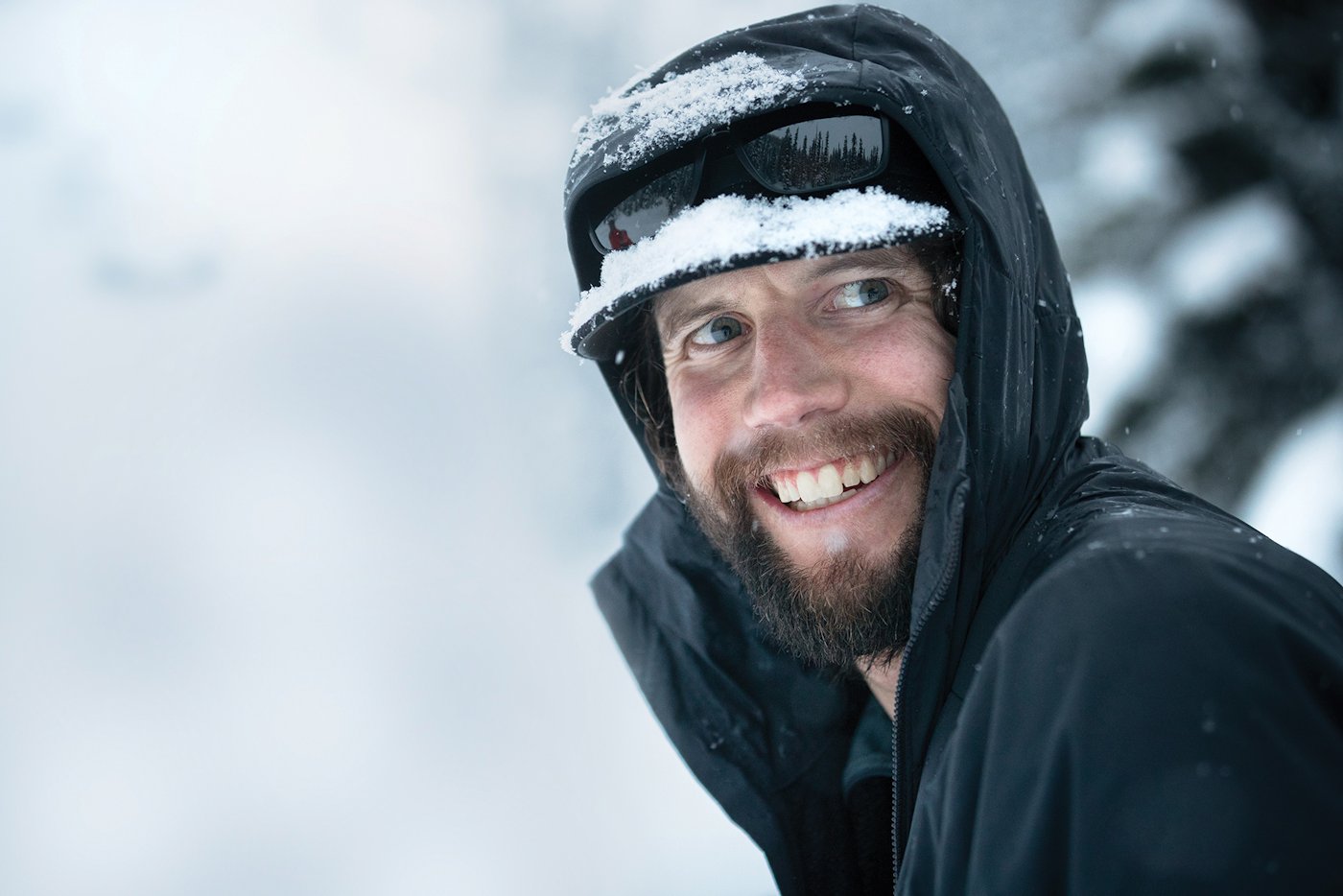
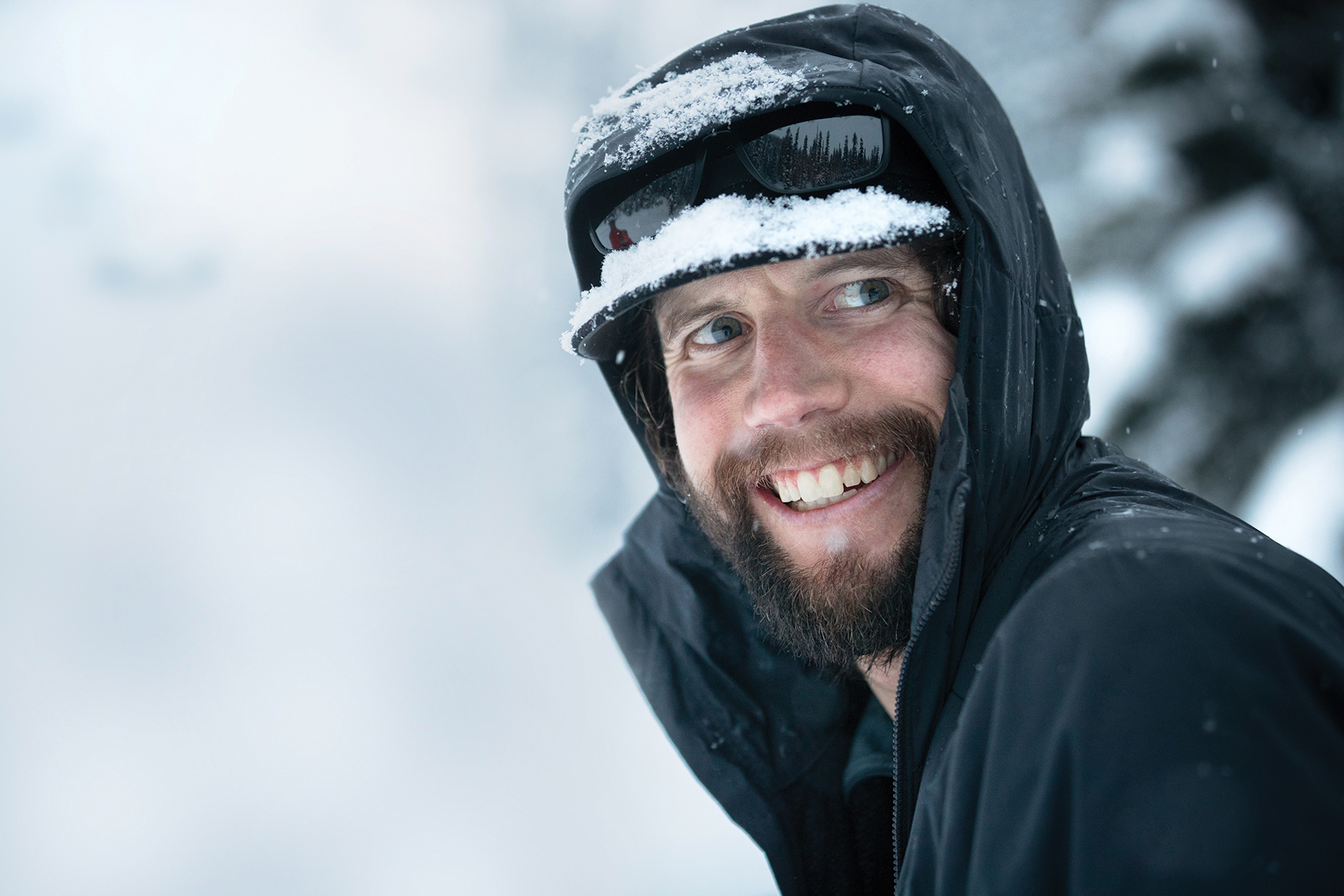
Location: Esplanade Range, BC
Folks like Sterbenz regard Hoji as a gifted athlete who has become a highly respected ski equipment developer. But instead of formal academic training, Hoji uses field experience and the help and guidance of a couple of key mentors.
In 2007, Hoji introduced freeski film audiences to ski mountaineering equipment, when he put out a human-powered segment on Dynafit Radical touring bindings in MSP’s Seven Sunny Days. In the film, he’s dropping cliffs on gear that, up until that point, no one trusted for those types of performances. He was the first young freeskier to cross over and become respected as a formidable athlete in human-powered skiing, mostly forgoing the lifts, choppers and snowmobiles.
Until he discovered AT boots and bindings and started innovating the gear to make it work for the kind of skiing he was doing, he felt stuck. He started gluing Vibram soles onto Tecnica race boots and trying to make his own walk modes. “I’ve been ski touring since I was a teenager, doing big-mountain skiing and I had this eureka moment with ski touring where I said, ‘I want to ski pillow lines but on alpine trekkers and alpine boots.’ Skiing at that time had given me so much fun and access, but we could only go downhill.”
Hoji credits Sterbenz and 4FRNT as his entry point into design. “The only reason I had an opportunity to be exposed to equipment development and design was through 4FRNT. That’s a big part of our relationship, why we’ve worked together for so long,” Hoji says. And after learning to make skis together under all kinds of adverse conditions, Hoji and Sterbenz eventually had documented proof of what he could do as a product designer.
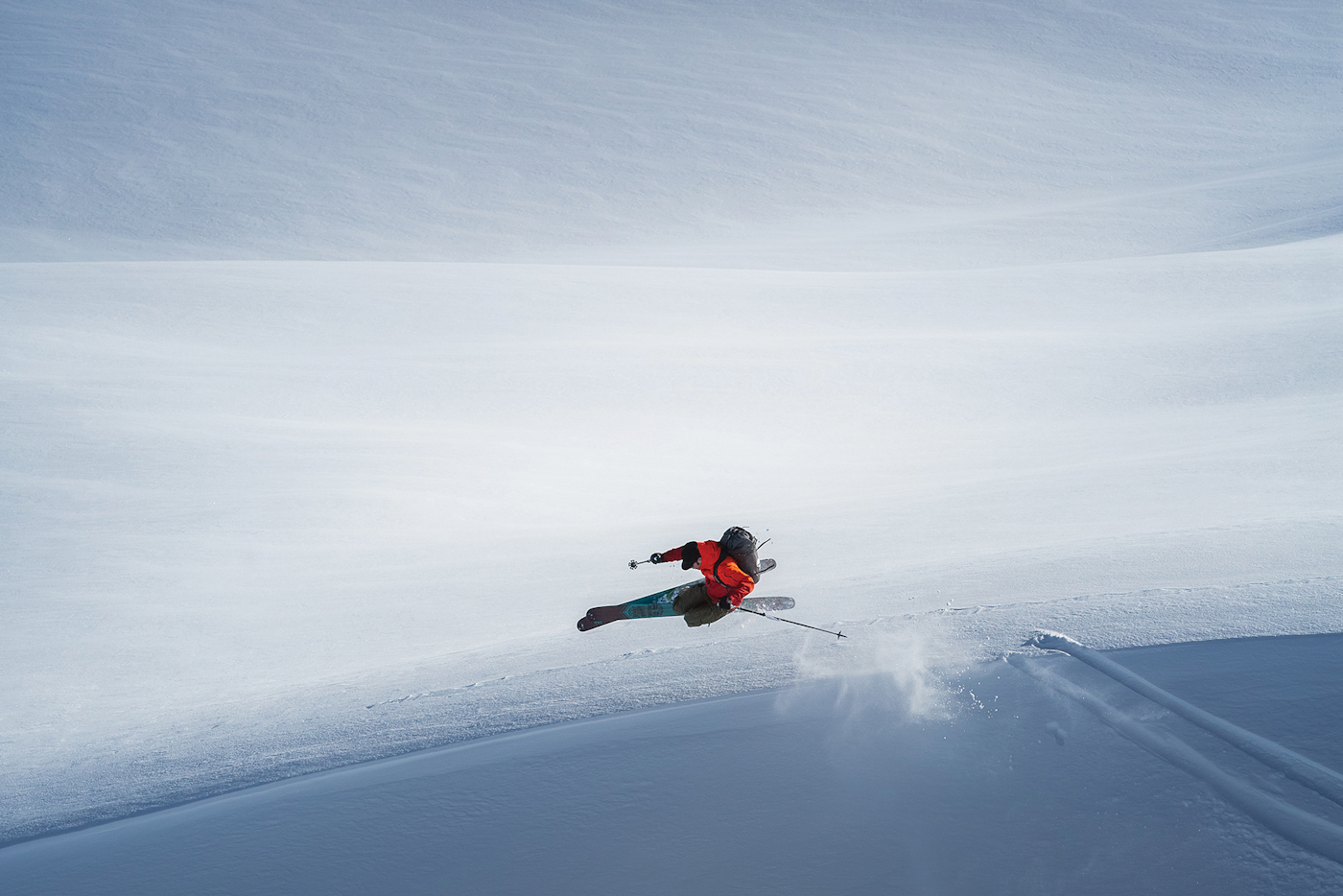
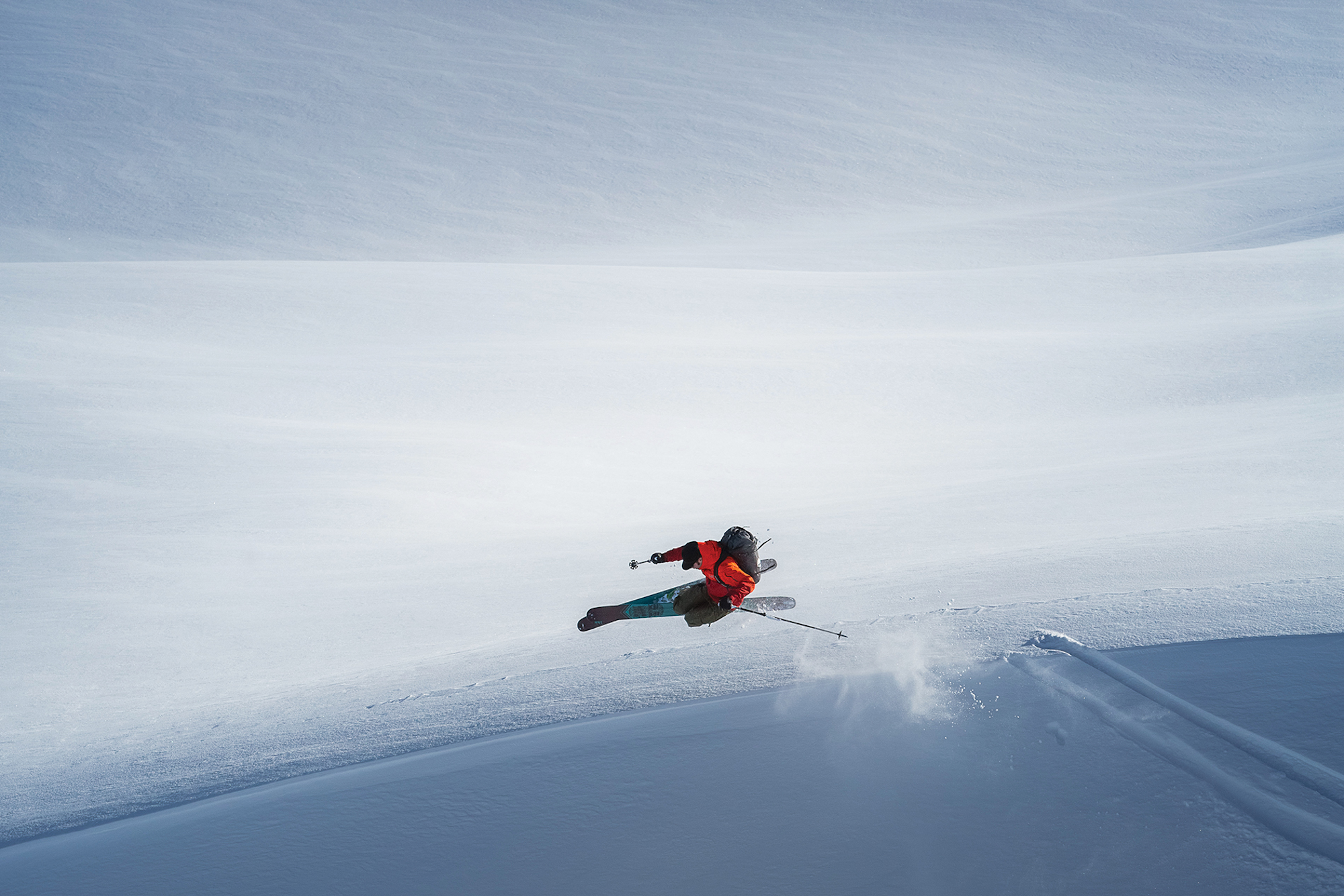
Location: Sentry Lodge, BC
In the fall of 2008, Sterbenz and Hoji developed the first Renegade, Hoji’s backcountry-oriented, signature 4FRNT ski. “We were developing a [ski] that enhanced his ability,” says Sterbenz. “We trusted him to develop a ski that skiers who were not at his level would still appreciate. The process evolved to where he was spending all of his time skiing in the backcountry. [His skis] had to be powerful enough to ski in front of the camera, drop cliffs, hit high speeds, but reliable, so as to not rely on only mechanized ascents.”
Hoji built the ski, took the one pair in existence off the press and went to Alaska to ski on it. He was hooked after that. “That was super addictive… I never wanted to ski on something I hadn’t built again.”
When MSP released The Way I See It in the fall of 2009, Hoji was seen dropping massive pillows in the BC Interior on his Renegades outfitted with Dynafit bindings and Dynafit Titan boots. This brought newfound attention to the human-powered freeride segment from a broader audience in the North American market.
Having shown the world what he was capable of skiing on Dynafit products, Hoji also grabbed the attention of that company. According to Dynafit GM Benedikt “Beni” Boehm, Hoji was convincing enough and strong enough to get a shot with the brand. “He’s definitely the fittest free-touring athlete I’ve ever seen. For not being a ski touring racer, he can really keep up,” says Boehm. “Hoji is really important in the segment that he stands for.”
As one of the brand’s first sponsored freeride athletes, Hoji was insistent on, and instrumental in, the development of a fully-certified tech binding. Hoji worked with the Dynafit team to bring the revolutionary Beast binding to life. The Beast 16 featured a sophisticated release mechanism that allowed release from both the toe and heel pieces, while the steel toe piece rotated to minimize pre-release. At the time, it was the lightest weight tech binding with a release value of 16.
As Eric “Hende” Henderson, former professional skier and PR manager for Dynafit tells it, “This is when he was quickly recognized not only for his skiing ability but for his energy and his design ability.”
It was also around this time, during the 2013-14 season when, in a backcountry hut deep in the middle of winter, the snow coming down hard outside, a group of skiers including Hoji and Fritz Barthel, legendary inventor of the first Dynafit pin-tech binding, were sitting around the fire stitching about, among other serious gear issues, having to pull their pant cuffs up all the time to switch from walk to ski mode.
Kindred tinkerers, Fritz and Hoji hit it off immediately. Hoji had already developed an “intelligent cable system” in his garage in Vancouver, out of sheer annoyance with having to pull his pant legs up at every transition. Fritz, also a skier first and an engineer second, immediately understood—as he himself says the pin-tech binding was also invented out of laziness—a desire to ski more and fuss less. The two ended up spending the next two weeks sequestered in Fritz’s basement laboratory shop in Germany, engineering a legitimate prototype, one foot at a time.
This was the foundation of what would become the Dynafit Hoji Pro Tour boot, released in fall 2018. The boot won every major award in the ski industry with its limited introduction in January 2018 at the Outdoor Retailer Snow Show in Denver.
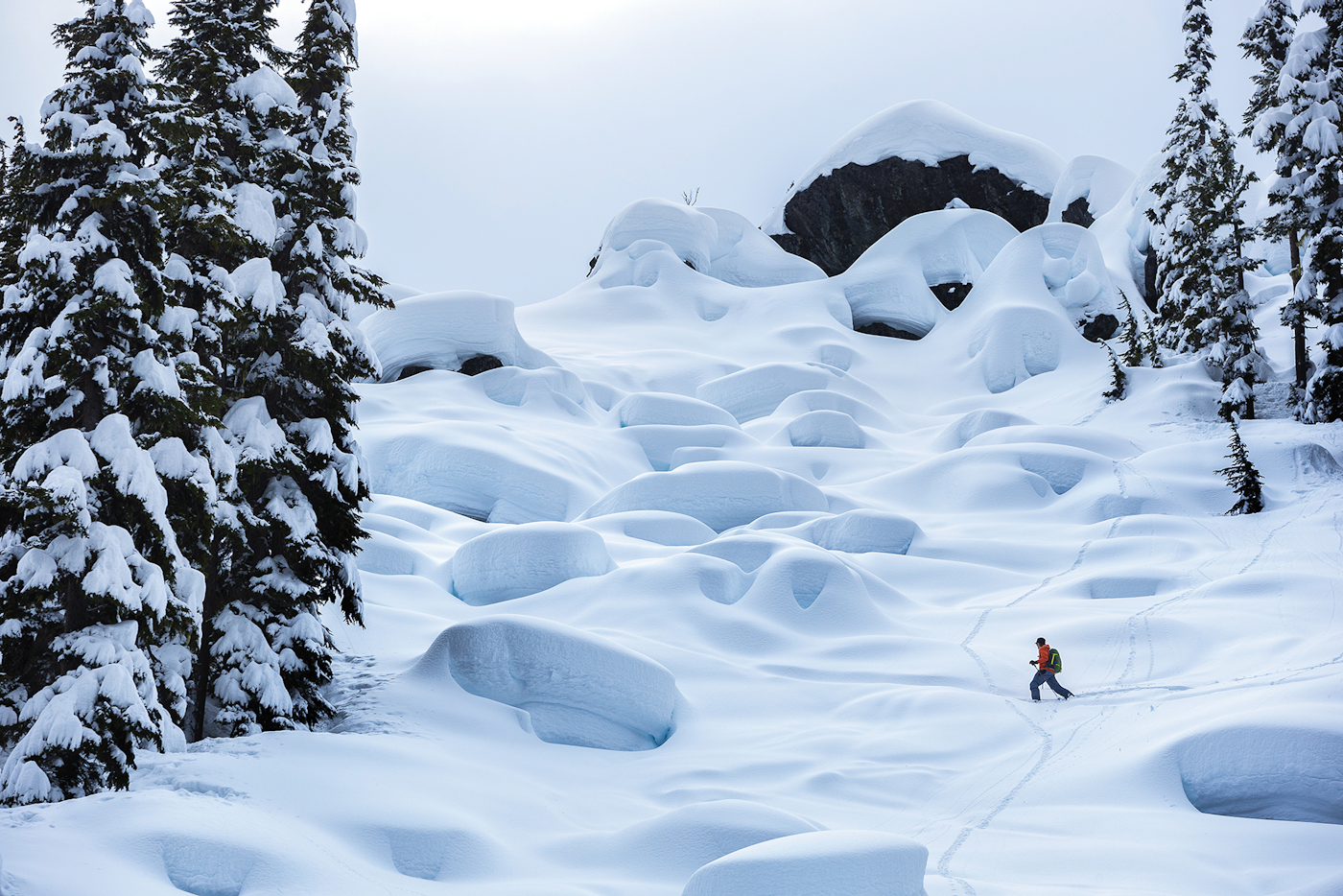

Location: Whistler Backcountry, BC
“I knew I had an idea for something that had never existed and needed parts that didn’t exist,” Hoji explains. “I told Fritz that I have this idea and the footwear guys aren’t interested, and he was instantly like, ‘Why don’t you come to my place after this trip, and we can build anything.’ He was very generous and welcoming, and basically I just showed up, went skiing and while I was there for two weeks, we built the first boot.”
Hoji took those prototypes home to Canada and, on his third day of testing, landed a big jump in the backseat and sheered off both walk mechanisms. He took all the broken parts back to Fritz, and they spent another three weeks pulling all-nighters, using the parts and materials as a baseline for production and accounting for real world forces to develop a new prototype. That brought them to a more refined boot that stood up for a whole season. “I wanted to make it happen so bad, and every prototype that we made got better and more refined,” Hoji says. “I wanted to build something that people would enjoy for as long as possible. The desire to make something that works so well and is so well thought of should be every product developer’s drive.”
Getting a new boot concept pushed through the European ski industry is next to impossible, especially if the idea comes from a young gun freerider from North America. “For someone to be as innovative as it requires and as hard working as he is, you have to be willing to take it on the chin along the way,” says Sterbenz. “Developers in companies don’t take it very well when you tell them their designs are flawed. He’s boldly put himself out there and, historically, insulted a lot of people—with Canadian charm of course—and an enormous amount of ‘please’ and ‘thank yous.’”
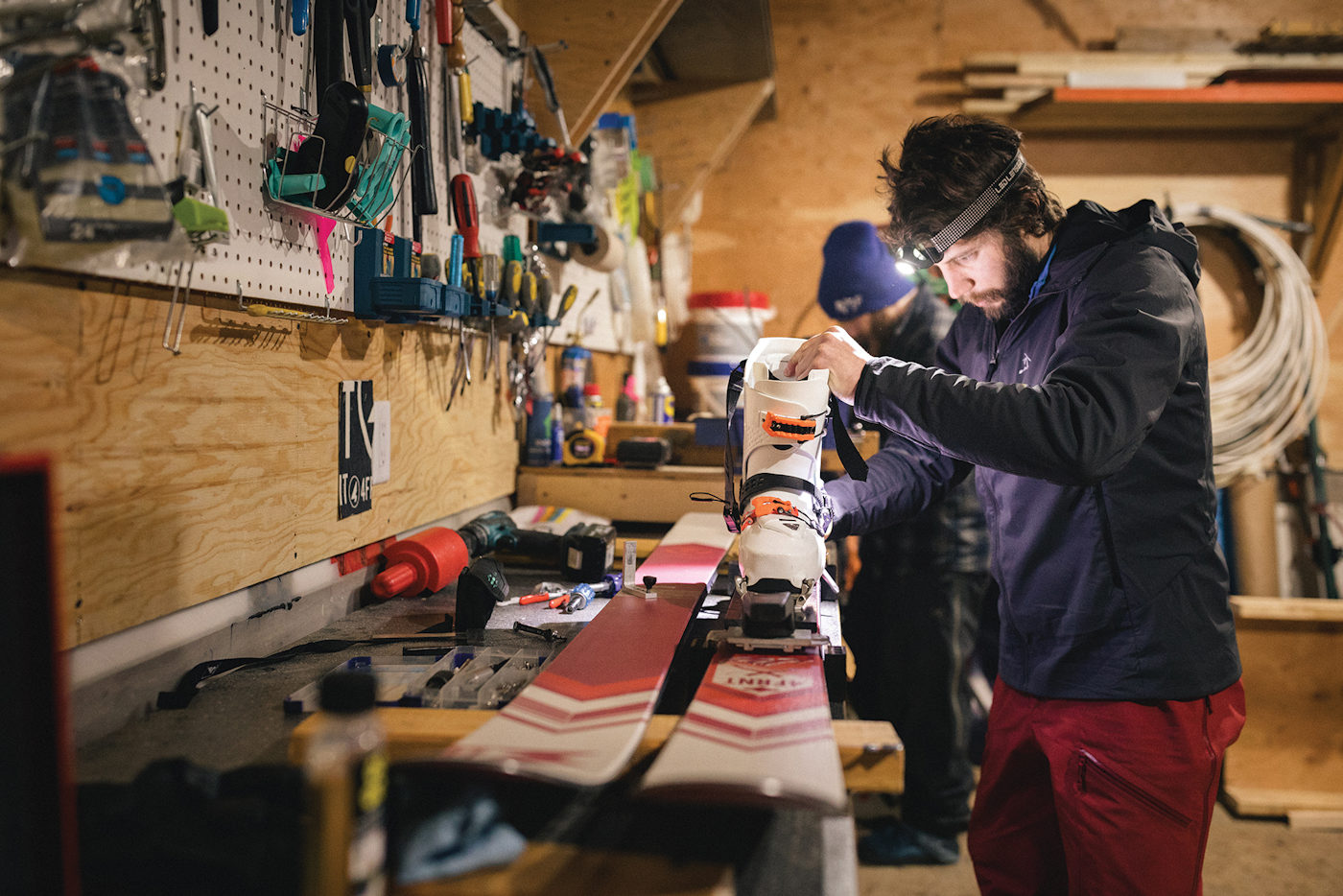

Location: Sentry Lodge, BC
But with Fritz’s support, they ended up getting a green light on what would be the next big leap for Hoji’s Dynafit projects. “He’s a loyal guy, and we respected that,” continued Boehm. “His personality, skills and dedication to our sport make him really important to us. We knew he was already starting to build around the Titan boots, but our Italian footwear colleagues are hard to convince. This project was coming out of day and night work down in Fritz’s basement.”
Hoji’s gear obsession mixed with an always helpful nature translates to his human interactions. Friends, brands and ski filming partners all agree that he does his best work in a backcountry environment, interacting with real people, real skiers. It’s his “high quarters” according to Sterbenz, as he’ll indirectly convince everyone on the trip to see the world of backcountry travel the way he does.
“He’ll go down into the gear room and start retrofitting people’s equipment overnight. That’s how he got the nickname Tinkerbell,” says Sterbenz. “He can be a total pain in the ass sometimes, but when shit hits the fan in the backcountry, and you get him on the radio, and he shows up with a bag of tools and his skills, he can fix any problem you may have and get everybody home at the end of the night. That’s what it’s all about.”
Fans and close friends also know that this level of perfectionism carries through to his line selection on the mountain. “He looks at something in a different way than anybody else,” says Henderson. “But he’s not a cowboy. The way he looks at terrain is the same way he looks at gear, that maybe it can be [skied] just a little bit better.”
Hoji came up at the same time as professional skier Chris Rubens. “The first time I remember skiing with him was at the Western Canadian Championships in the late ’90s, and to get down from the top of the course there was a groomed run, or you could rally through these trees and then into a mogul field,” says Rubens. “I was following him as he rallied through the trees and then sent it off the cat track into the mogul field. I remember being in disbelief that you could do that on skis, taking that much air into the mogul field.”
When Hoji broke into filming with MSP, Rubens was quick to find out about his helpful nature. “He put in the good word for me, and I got a chance to [shoot] with the biggest film company in skiing. This was huge for me and shaped my career into what it is today. Without his help, I’m not sure I would be where I am,” Rubens said. “Working with film crews really helped portray Eric as one of the most helpful humans ever. He was always making sure everyone else was dialed, was instrumental in communication in the field and then would step up to the gnarliest lines. I think this is one of the most important things about Eric: the ability to see the bigger picture and help achieve that goal while still pushing himself to the limit.”
Hoji has now been filming with MSP for 15 years in a continuous evolution. “Now he’s basically a brand within skiing,” says 4FRNT’s Sterbenz. “I think what really stands out for me personally is not just Eric the skier, but that he has really now become a brand, and that brand is not only in the design of product but in the style of skiing.”
With a full catalog of standout segments from nearly two decades of filming and significant admiration from every skier he’s ever filmed with, it was a no-brainer for MSP to produce a compilation film of the legendary skier.
“After getting so many emails from other pro skiers after shoots saying, ‘Can Hoji come on every trip?’ we ultimately knew this movie had to be made,” says MSP producer Murray Wais. “His presence brings everybody up. It’s a unique spot to be in because, as a pro skier, your job is to get rad, and it’s a little bit of a competition on shoots. But he doesn’t get wrapped up in that.”

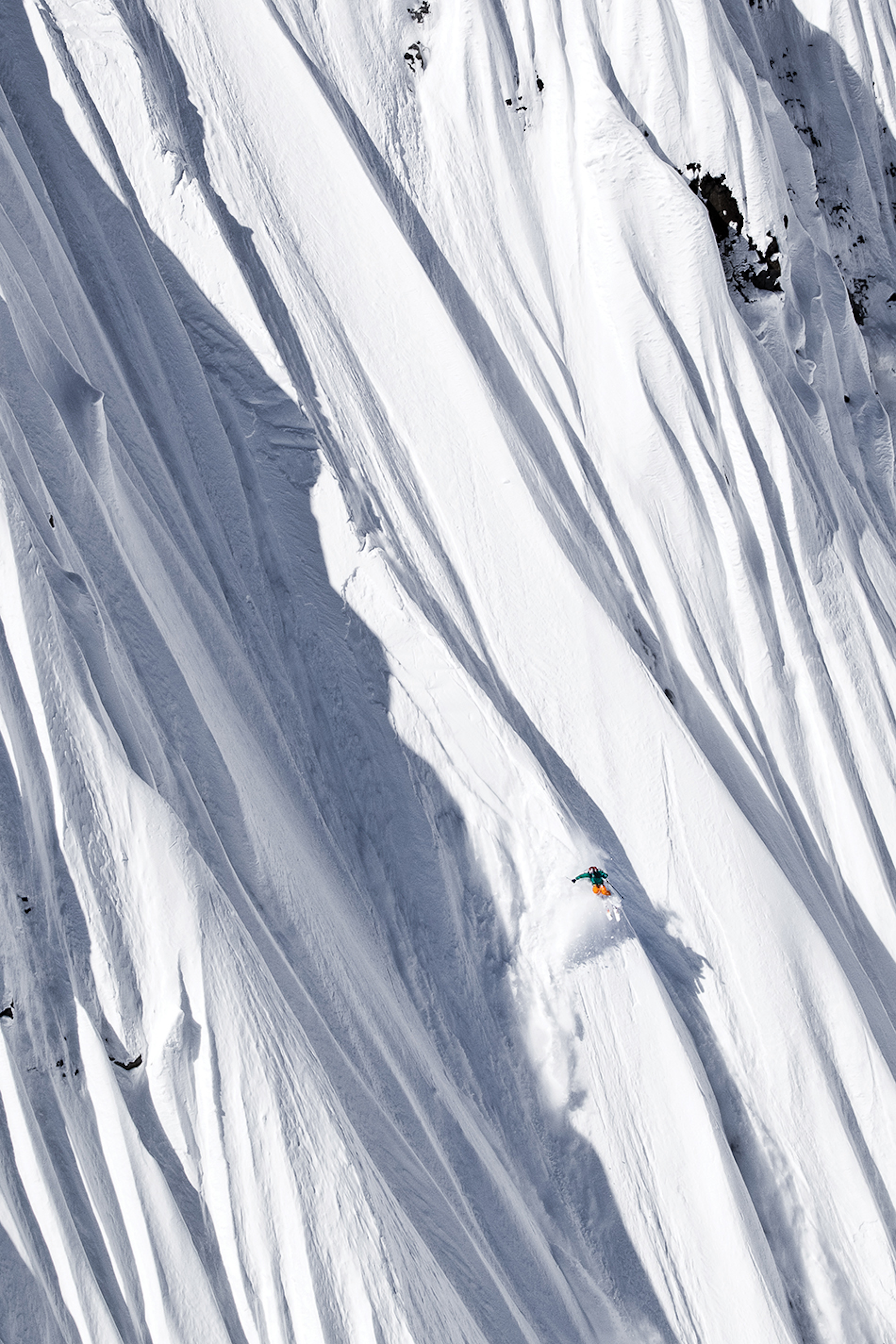
Location: Pemberton, BC
“I’ve said for years that if you stacked all of Hoji’s MSP segments on end, he’d have one of the greatest film performances in the history of skiing. But beyond that, I feel like he still has this underground allure,” adds MSP director Scott Gaffney, who edited 15 years of footage for the project. “He isn’t an in-your-face kind of ski star. I’ve often referred to him as a skier’s skier. He’s a true ski bum who happens to be a pro. His style, ability and balls have inspired a legion of fans, but he’s simply let his skiing do the talking all along.”
With such a diverse audience—young, old, familiar and not—that will have the opportunity to see it, the film has a palpable buzz surrounding it. Whether it’s decades-long MSP fans reliving some of the best skiing Hoji has produced in his storied career, friends that have seen it firsthand or a younger generation of moviegoers experiencing Hoji’s on-screen magic for the first time, the movie will stand on its own among many of the production house’s best.
“If there’s a film that’s going to be centered around an individual, the pinnacle of influence in a lineage of skiing, that’s Eric,” says Sterbenz. “There’s an element of curiosity that needs to be appeased. This is going to help people realize his level of impact on freeskiing as a whole and his influence on developing product that’s paved the way for freeskiing to be where it is today.”
“His devotion to this sport is a story that’s simply worth immortalizing,” adds Gaffney.
Hoji, humble as ever, believes that the film is more than just about his ski career, though, taking the time to credit the long list of people that have been with him through it all. “It’s my journey but also my mentors’, my ski coaches’, the whole cast of characters who have allowed this incredible journey to come true for me,” he says. “It’s my contribution to the sport.”

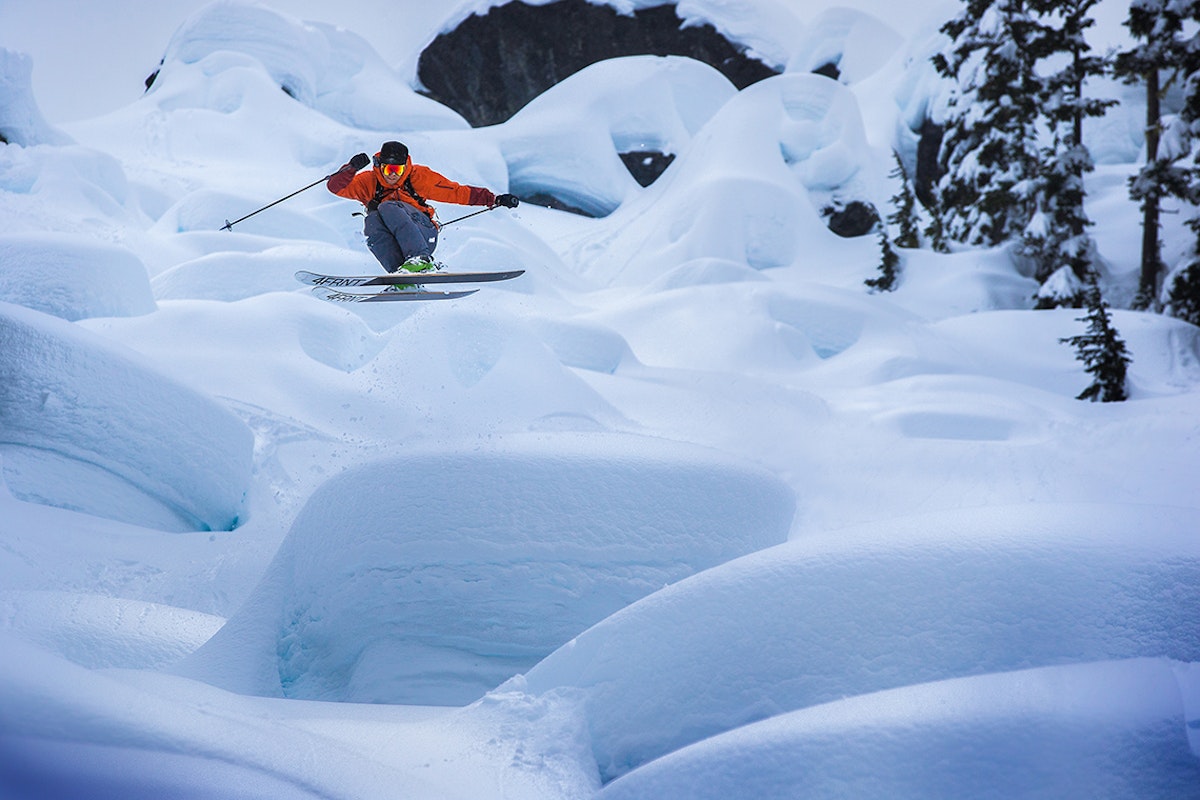
![[GIVEAWAY] Win a Legendary Ski Trip with Icelantic's Road to the Rocks](https://www.datocms-assets.com/163516/1765233064-r2r26_freeskier_leaderboard1.jpg?w=200&h=200&fit=crop)
![[GIVEAWAY] Win a Head-to-Toe Ski Setup from IFSA](https://www.datocms-assets.com/163516/1765920344-ifsa.jpg?w=200&h=200&fit=crop)

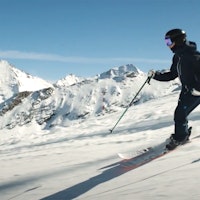
![[GIVEAWAY] Win a Legendary Ski Trip with Icelantic's Road to the Rocks](https://www.datocms-assets.com/163516/1765233064-r2r26_freeskier_leaderboard1.jpg?auto=format&w=400&h=300&fit=crop&crop=faces,entropy)


![[GIVEAWAY] Win a Head-to-Toe Ski Setup from IFSA](https://www.datocms-assets.com/163516/1765920344-ifsa.jpg?auto=format&w=400&h=300&fit=crop&crop=faces,entropy)


